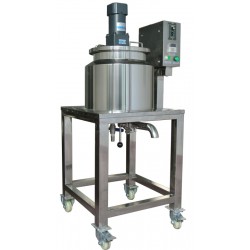Tank and Melter
The products we present to you are here for your reference. We work with our suppliers to offer you fully customized solutions for your needs and at the best prices. If you have doubts about the most suitable material for your production do not hesitate to consult us.
Principle of operation of a melter
- A melter is a double or triple stainless steel tank (stainless steel) that can heat a mixture in the manufacture of food products, cosmetics or pharmaceuticals. The third envelope is optional and sometimes comes to add an insulating layer.
- In many cases, the melter is equipped with one or more mixing systems. There are 3 main types:
- The homogenizer which can be placed at the bottom or top of the tank and which rotates extremely fast (generally at about 3000 rpm) and whose purpose is to obtain a product emulsion that is both stable and homogeneous
- The mixer, simpler and slower, which as the name suggests is used to mix the product
- The scraper or scraper blade that scrapes the inner wall of the melter to prevent the product sticks to the tank
Autonomous melter
- It is electrically connected and heats the mixture by joule effect thanks to electric resistances. The temperatures achievable using this method are of the order of 130 ° Celsius.
Melter with steam supply
- In this configuration, the melter must be fed with an external water system. These melters are cheaper but require a water circuit available inside the manufacturing room unlike the autonomous melter that can start immediately. The attainable temperature is of the order of 80 to 90 ° Celsius.
Important parameters
Depending on your product, the size of your production but also the topology of your production workshop we work with you to determine the following characteristics in order to offer you the most suitable solution:- The capacity or volume of the tank in liters
- The mixing system (possible combinations with homogenizer, mixer and scraper)
- The locations and diameters of the inlet systems for the products and for the water or oil circuit
- The pressure that the melter has to bear (this affects the shape of the lid)
- The need to create additional taps for measuring instruments (temperature probe, pressure sensor, etc.)
- The location and diameter of the product output
- The cleaning system
Applications
Our tanks and melters allow the manufacture and storage of food and cosmetic products (chocolate melter, melter for cosmetic creams, honey, etc ...)
There is 1 product.
Showing 1-1 of 1 item(s)

